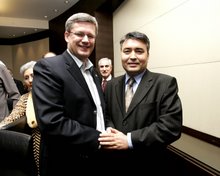Uyghur American Association condemns demolition of Kashgar Old City
Press Releases
For immediate release
March 24, 2009, 5:10 pm EST
Contact: Uyghur American Association +1 (202) 349 1496
The Uyghur American Association (UAA) condemns the demolition of traditional Uyghur buildings in Kashgar Old City, an initiative that will eradicate an ancient, irreplaceable center of Uyghur culture. Recent reports from official Chinese media indicate that authorities are implementing a “residents resettlement project”, which aims to relocate 65,000 Uyghur households (220,000 people) currently in Kashgar Old City. The target of the “residents resettlement project” is to relocate 45,000 Uyghur households and to demolish five square kilometers of Kashgar Old City in the first five years of the project. In 2008, the State Council of the National People’s Congress designated nearly three billion Yuan to the project.
A number of traditional Uyghur communities in East Turkestan have been destroyed since the beginning of Chinese Communist Party administration in 1949. Most of this destruction has come in the form of mass-campaigns, such as the Cultural Revolution (1966-1976), which targeted historical aspects of Uyghur culture. In particular, the Chinese government destroyed all Uyghur cultural centers in northern East Turkestan one after another, first by removing the Uyghur population, then demolishing their traditional homes, and finally by scattering them into apartment buildings surrounded by Han Chinese neighbors, and isolating them as one unified people.
As Kashgar Old City is one of the few remaining centers of traditional Uyghur culture and religion, many Uyghurs consider protection of Kashgar Old City as vital to maintaining a separate Uyghur identity. Kashgar Old City contains over eight square kilometers of traditional Uyghur homes, bazaars and centers of worship, such as the six hundred year old Id Kah Mosque.
In official Chinese media, government authorities have stated that the demolition was initiated by the need to protect Old City residents from homes prone to earthquake damage and poor drainage. However, UAA fears that the demolition stems from a long-standing campaign to dilute Uyghur culture and identity. In recent years, the government of the People’s Republic of China has overseen policies which are phasing out Uyghur as a language of instruction in schools, forcibly transferring young Uyghur women to work in factories in eastern China, and encouraging the mass in-migration of Han Chinese to East Turkestan.
Uyghur democracy leader, Ms. Rebiya Kadeer, said “the demolition of Kashgar Old City is an affront to Uyghur identity and is an attempt to assimilate Uyghurs. Chinese authorities have unilaterally decided that Uyghurs should be moved from their traditional homes and livelihoods without any consultation. Not one Chinese official has stated what will become of the land left behind after the bulldozers have done their job. I lament the loss of such a unique site of world heritage, and call on people across the globe to let the Chinese government know that this demolition robs the world of an irreplaceable community. The demolition of Kashgar Old City is equal to the destruction of thousands of years of Uyghur culture built upon the famous Silk Road.”
Quoted in a March 24, 2009 Washington Post report, Professor Wu Dianting, of Beijing Normal University's School of Geography, said “The old town also reflects the Muslim culture of the Uighurs very well -- it has the original taste and flavor without any changes…Here, Uighur culture is attached to those raw earth buildings. If they are torn down, the affiliated culture will be destroyed.”
In addition, the Washington Post report detailed the resettlement of 100 Kashgar Old City families into new apartment-block style housing. According to UHRP sources, the new housing is located approximately eight to nine kilometers from Kashgar city center. UAA is concerned that the resettlement of Uyghurs into government-organized living arrangements far from traditional Uyghur centers is a measure to control and monitor Uyghur activity, as well as to create a dependence on the Chinese government.
Chinese official, Wang Zhengrong, stated that not all of the Old City is earmarked for demolition and that sections will be “protected, managed, and developed” with the aim of “creating international heritage scenery”, which will increase income from tourism. Wang added that under the plans tourists will still be able to view “minority lifestyle and architectural characteristics.” UAA is concerned that the remaining sections of the Old City will take on the characteristics of an open-air museum of Uyghur culture, where once a vibrant community lived. The value of tourism to the Kashgar economy is approximately 620,000,000 Yuan. So far, no indication has been given as to who will be the beneficiaries of a Chinese-managed Kashgar Old City.
The Chinese state has attempted to redefine what it means to be Uyghur. The period leading up to and during the Beijing Olympics highlighted Uyghur identity, its deterioration under the Chinese state and the acceleration of that process due to the Games. When the Olympic torch relay passed through East Turkestan’s cities in June 2008, Uyghur dancers were brought out to display what is thought of as a non-threatening aspect of Uyghur culture, and exemplify the virtues of living in a “harmonious society”. However, most Uyghur residents of the cities along the torch relay were told to stay inside their homes during the event, while Han residents were lined up alongside the torch’s route to welcome its passage. A heavy security presence accompanied the passage of the Olympic torch in East Turkestan, including police checks of vehicles, numerous snipers and warnings to residents to stay inside their buildings with their windows shuttered.
Indicative of the way in which Uyghurs are portrayed as a minority people, the opening ceremonies of the Beijing Olympics included 56 smiling children paraded into the Olympic stadium who were said to belong to the PRC’s 56 “ethnic minority” groups, including the Uyghurs. However, all 56 children were Han Chinese.
UAA calls on the international community, in particular UNESCO, to ask the Chinese government to halt the demolition of Kashgar Old City, as well as to ask the Chinese government to comply with its domestic laws concerning the protection of minority identity.
Related other sources:
http://www.washingtonpost.com/wp-dyn/content/article/2009/03/23/AR2009032302935.html
http://www.xj.chinanews.com.cn/newsshow.asp?id=65729&ntitle=f48f9196d221900ece284bab63411bdf
http://www.chinanews.com.cn/gn/news/2009/02-28/1582506.shtml
http://www.xj.chinanews.com.cn/newsshow.asp?id=65702&ntitle=2340ab2b98a8919ffbf81b1685c9070d
Wednesday, March 25, 2009
Subscribe to:
Post Comments (Atom)






No comments:
Post a Comment